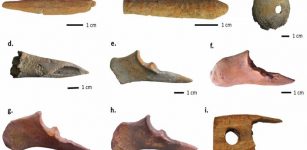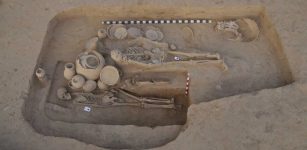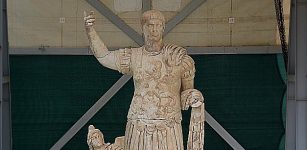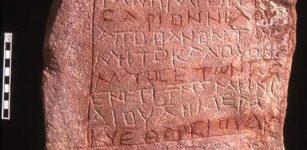Why Did Pirates And Sailors Wear Earrings?
AncientPages.com - Ancient pirates and sailors wore earrings for a number of reasons. Earrings were a sign of their travels and voyages. Young sailors received earrings to commemorate their first crossing of the equator, or when they rounded the treacherous waters of Cape Horn, the southernmost tip of South America.
Earrings were also worn for superstitious reasons. Some pirates believed that the precious metals in an earring possessed magical healing powers. They were convinced that wearing an earring would improve or even cure bad eyesight. There were also those who thought that pierced ears would prevent seasickness. A gold earring served often as a protective talisman preventing a person from drowning.
See also:
Viking Children Were Buried With Extremely Sharp Knives – Afterlife Tools To Be Used In Valhalla?
Ancient Roman Women Wore Bikini In 1400 B.C.
Did Captain Robert Jenkins’ Ear Start A War That Lasted 9 Years?
Earrings made of gold and silver were used as money. If a pirate or sailor drowned and washed up on the beach, the earrings would serve as payment for a proper Christian burial. Sometimes, they engraved the name of their home port on the inside of the earring so that their bodies could be sent to their families for a proper burial.
Earrings also protected pirates against hearing loss. Pirates firing the ships' cannons during close combat with the enemy dangled wads of wax from their earrings to use as earplugs.
So, earrings certainly served a number of purposes.
Copyright © AncientPages.com All rights reserved. This material may not be published, broadcast, rewritten or redistributed in whole or part without the express written permission of AncientPages.com
Expand for referencesMore From Ancient Pages
-
 Rare Stone Age Artifacts Found In Norway Offer Evidence Of Migration From The East
Archaeology | Aug 24, 2023
Rare Stone Age Artifacts Found In Norway Offer Evidence Of Migration From The East
Archaeology | Aug 24, 2023 -
 Ancient Bizarre Experiments Conducted In Mysterious Underground Temple
Ancient Mysteries | Jun 28, 2018
Ancient Bizarre Experiments Conducted In Mysterious Underground Temple
Ancient Mysteries | Jun 28, 2018 -
 Monumental Totem Poles Of Native American People Tell Stories Of Ancestors
Featured Stories | May 22, 2017
Monumental Totem Poles Of Native American People Tell Stories Of Ancestors
Featured Stories | May 22, 2017 -
 Why Was The Face Of Mysterious Ust-Taseyevsky Stone Idol Suddenly Changed?
Archaeology | Jan 18, 2021
Why Was The Face Of Mysterious Ust-Taseyevsky Stone Idol Suddenly Changed?
Archaeology | Jan 18, 2021 -
 Batavia Shipwreck Reveals Secrets Of 17th-Century Dutch Seafaring Domination
Archaeology | Oct 30, 2021
Batavia Shipwreck Reveals Secrets Of 17th-Century Dutch Seafaring Domination
Archaeology | Oct 30, 2021 -
 Dragon Man: New Species Of Human May Replace Neanderthals As Our Closest Relative
Archaeology | Jun 26, 2021
Dragon Man: New Species Of Human May Replace Neanderthals As Our Closest Relative
Archaeology | Jun 26, 2021 -
 More Sophisticated Manufacturing In The Bronze Age – New Evidence
Archaeology | Jun 27, 2020
More Sophisticated Manufacturing In The Bronze Age – New Evidence
Archaeology | Jun 27, 2020 -
 On This Day In History: Julian ‘The Apostate’ Died During The Retreat From The Sassanian Empire – On June 26, 363
News | Jun 26, 2016
On This Day In History: Julian ‘The Apostate’ Died During The Retreat From The Sassanian Empire – On June 26, 363
News | Jun 26, 2016 -
 Beads Show European Trade In African Interior Used Indigenous Routes
Archaeology | Sep 17, 2022
Beads Show European Trade In African Interior Used Indigenous Routes
Archaeology | Sep 17, 2022 -
 Roman Theater Unearthed After 1,700 Years Near Western Wall In Jerusalem
Archaeology | Oct 19, 2017
Roman Theater Unearthed After 1,700 Years Near Western Wall In Jerusalem
Archaeology | Oct 19, 2017 -
 Mystery Of The Gotland Grooves – Ancient Astronomical Observatory?
Civilizations | May 11, 2016
Mystery Of The Gotland Grooves – Ancient Astronomical Observatory?
Civilizations | May 11, 2016 -
 Scientists Use Ancient DNA To Explore Early European Adaptation
DNA | Nov 27, 2024
Scientists Use Ancient DNA To Explore Early European Adaptation
DNA | Nov 27, 2024 -
 Unique Statue Of Roman Emperor Trajan Unearthed In Ancient City Of Laodicea,Turkey
Archaeology | Apr 12, 2019
Unique Statue Of Roman Emperor Trajan Unearthed In Ancient City Of Laodicea,Turkey
Archaeology | Apr 12, 2019 -
 Why Is Europe Called Europe?
Ancient History Facts | Apr 21, 2016
Why Is Europe Called Europe?
Ancient History Facts | Apr 21, 2016 -
 First Detailed Academic Study Of East African Maritime Traditions Shows Changes In Boatbuilding
Archaeology | May 11, 2022
First Detailed Academic Study Of East African Maritime Traditions Shows Changes In Boatbuilding
Archaeology | May 11, 2022 -
 Societies In Iberian Peninsula Deployed “Escape Economics” 4,000-Year-Old
Archaeology | Sep 28, 2022
Societies In Iberian Peninsula Deployed “Escape Economics” 4,000-Year-Old
Archaeology | Sep 28, 2022 -
 Nabataean Culture Lived On Long After Their Kingdom Disappeared – New Evidence
Archaeology | Feb 27, 2019
Nabataean Culture Lived On Long After Their Kingdom Disappeared – New Evidence
Archaeology | Feb 27, 2019 -
 First Animals On Earth Could Have Evolved Much Earlier Than The Oldest Fossils Suggest
Fossils | Oct 13, 2022
First Animals On Earth Could Have Evolved Much Earlier Than The Oldest Fossils Suggest
Fossils | Oct 13, 2022 -
 Rare Medieval Chess Piece And Game Collection Unearthed At A Forgotten Castle
Archaeology | Jun 7, 2024
Rare Medieval Chess Piece And Game Collection Unearthed At A Forgotten Castle
Archaeology | Jun 7, 2024 -
 Only One In Four Western Roman Emperors Died Of Natural Causes
Archaeology | Oct 15, 2021
Only One In Four Western Roman Emperors Died Of Natural Causes
Archaeology | Oct 15, 2021

